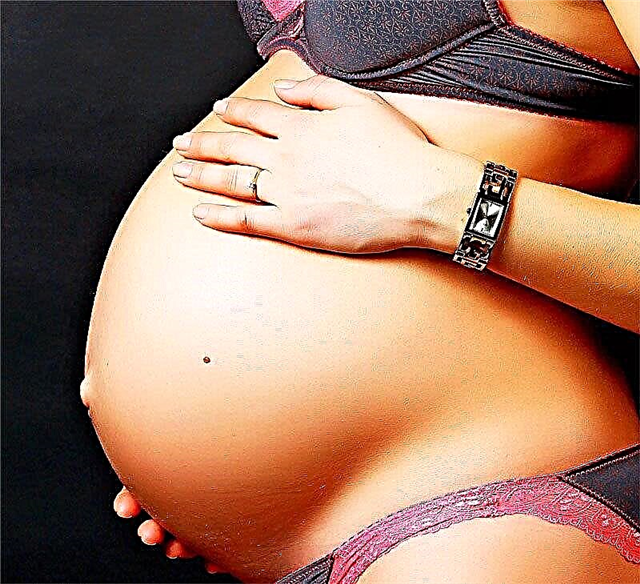
The postpartum period is very difficult for the female body. It requires special attention from doctors and the mother herself, because some complications may not appear immediately and cause serious harm to the woman. Clots that do not want to leave the uterine cavity are one of these complications.

Regeneration and involution of the uterus
The uterus, in which the baby grew up, increased during pregnancy more than 500 times, the ligaments were stretched, became thinner. As soon as the baby is born, a gradual reverse development (involution) of the reproductive organ begins. During the first day, the uterus does not leave the abdominal cavity, it is still large to fit in the small pelvis.
Only after one and a half to two months the uterus will reach almost the same size that was characteristic of it before pregnancy - the uterus will weigh about 60-70 grams, and its volume will be no more than 5 ml.

After childbirth, the myometrium gets rid of excess muscle fibers. And it happens in a very interesting way - fibers that have now become unnecessary, access to the blood supply is simply blocked - the vessels are closed, as a result, the excess fiber, which has fulfilled its natural purpose, dies off and is taken out in the form of the most ordinary blood clots. The placental wound (the place where the placenta was adhered) also bleeds, and already on the second day after childbirth, the natural clotting processes will lead to the formation of a certain amount of blood clots, which will also come out through the genital tract.
Sometimes, under the influence of a variety of situations, the clots do not come out or do not come out completely, and then the remaining ones inside the reproductive organ cause difficult processes in the woman's body.
It is possible to suspect clots by characteristic symptoms, and confirm or deny the assumption - according to the results of ultrasound.

Symptoms and Causes
The first 2-3 days after birth, the release of clots is an absolute norm. The uterus gets rid of lochia (postpartum discharge, consisting of dying uterine fibers, cervical mucus and blood from disturbed vessels of the placental wound).
Then, during the first 1-2 weeks after childbirth, a small number of clots without additional alarming symptoms may also be the norm, but only if the woman is characterized by heavy menstruation with a large number of clots.
The fact that foreign objects (in particular, blood clots) remain in the uterus are said symptoms such as intense abdominal pain, impaired outflow of lochia due to a clot stuck in the cervix (the discharge is too scarce, and then abruptly - abundant, and then absent again), increased body temperature... On palpation of the abdomen, the bottom is tense, painful. Sami the discharge may have an unpleasant odor.

In the maternity hospital, before discharge, an ultrasound scan is done to all women in childbirth - the rate of involution of the uterus is assessed, as well as the degree of cleansing of its cavity. But the problem is insidious. It may appear later, when the woman has already left the hospital, and in this case, a vigilant attitude towards the above symptoms will help to assess the situation in time and immediately consult a doctor for help, because here you cannot do with decoctions of herbs - you need qualified and timely help.
The frequency of violation of the involution of the uterus occurs in about 2% of cases... The myometrium behaves abnormally - it contracts very slowly or too rapidly, or does not contract at all. In all cases, there is a risk that the outflow of lochia will be impaired, and then clots can linger in the uterine cavity.
Most often, impaired uterine contractility occurs in women who:
- bore a large fetus (muscles are overstretched);
- suffered from polyhydramnios;
- suffer from an infectious lesion of the membranes of the uterus (infection could occur during childbirth, and after them as an independent complication).
Clots that remain in the uterus may be particles of the placenta, if the obstetrician who delivered the baby did not correctly or carefully performed the so-called revision - did not feel the uterine cavity after the birth of the placenta, did not collect all the fragments of the placenta into a single whole on the obstetric table, did not make sure, that the "baby's place" has completely left the womb. Particles of membranes may remain in the uterus.
Clots, which, as we found out, come out for quite natural reasons, can create a congestion in the cavity of the reproductive organ, if the contractility is impaired - there is a deficiency of the hormone oxytocin in the body, there were many births, a woman for some reason is unable to breastfeed her baby ... During nipple stimulation during breastfeeding, the production of oxytocin is stimulated, which increases the outflow of the contents of the uterine cavity to the outside.
Recently, clots in the uterus after childbirth are not as common as 30 years ago, when ultrasound did not have a wide diagnostic distribution and obstetricians could only guess about whether there was something in the organ cavity or not.

What to do?
If, nevertheless, this happened to you, then it should be understood that there is only one task - to remove blood clots from the cavity of the reproductive organ as soon as possible, since they contribute to the spread of the inflammatory process, subinvolution and deterioration of the condition. If left untreated, sepsis or massive uterine bleeding may occur, which may even be fatal.
There are two ways to get rid of clots. Usually they start with the first - medication and resort to the so-called cleaning (vacuum aspiration or curettage) only when the drugs do not lead to the desired result - it was not possible to remove the clots.

If the reason is weak contractility, and the cervix is free, not clogged, then using hormone-reducing drugs such as oxytocin. It stimulates contractility. Antibiotics may be prescribed at the same time.... In some cases, washing the uterine cavity with antiseptic solutions is used. The treatment regimen also includes hormones and antibacterial drugs, anti-inflammatory drugs.
Cleaning, if indicated, is also not worth fearing - it will not hurt, since the procedure is performed only after the woman is injected with an intravenous anesthetic, which will immerse her in a deep sleep. They do not clean for long - about 5-7 minutes... Then they immediately transfer the woman to the ward, where in another 15-30 minutes she will wake up.
If blood clots are found in the uterus in the maternity hospital, they are discharged not for 3-5 days, but laterwhen the woman is helped. From the gynecological department, where a woman can get from home, if symptoms appear after discharge, they are usually discharged after 1.5-2 weeks.
Prevention measures
So that the problem does not affect you, it is important to follow some rules in the first hours and days after giving birth. Not everything in this list depends on the woman herself, but what depends on her must be strictly followed.
- After the birth of the placenta, ice is applied to the woman's abdomen. And although doctors have recently been trying to dispute the benefits of this action, long-term practice is just that - ice is needed to stop bleeding in a placental wound. Too much blood loss can lead to a variety of complications.

- Apply the baby to the breast more often, especially in the first few days after birth - each application stimulates the production of oxytocin.

- If the birth was natural, try to lie on your stomach in any free minute - this contributes to the contraction of the myometrium.
- Get up earlier, do not lie in bed - in the upright position of the body, the discharge of lochia according to the laws of gravity proceeds better.
- Try to change your postpartum pads every 2-3 hours to reduce the chance of bacteria growing in your lochia.

- Be attentive to your condition. In case of abnormal discharge, an increase in body temperature, pain in the lower abdomen, a feeling of "bloating" of the abdomen (often with stagnation), with a sharp cessation of discharge in the early postpartum period, immediately consult a doctor.


The following video will tell you about the features of postpartum discharge.



